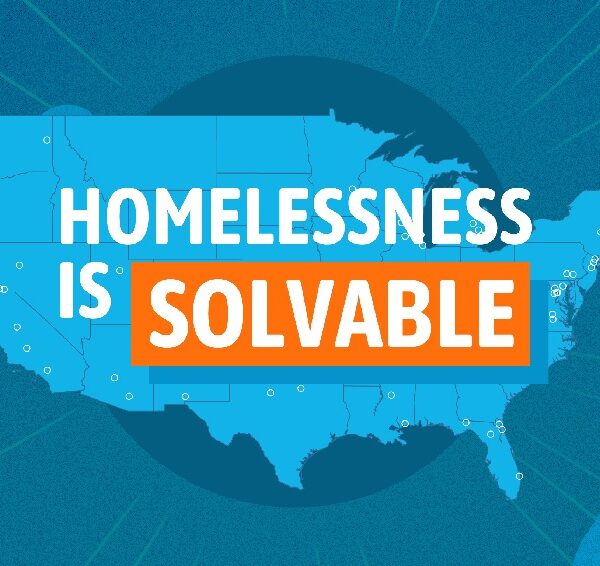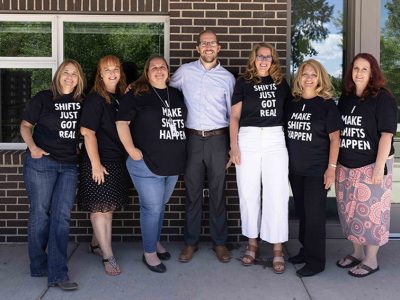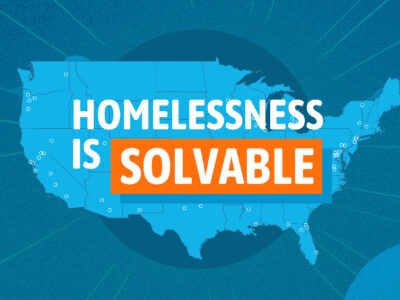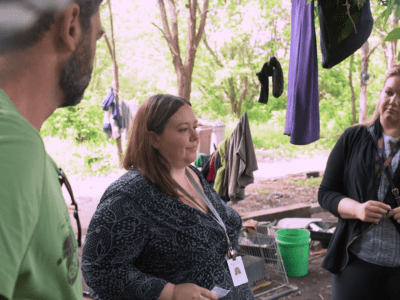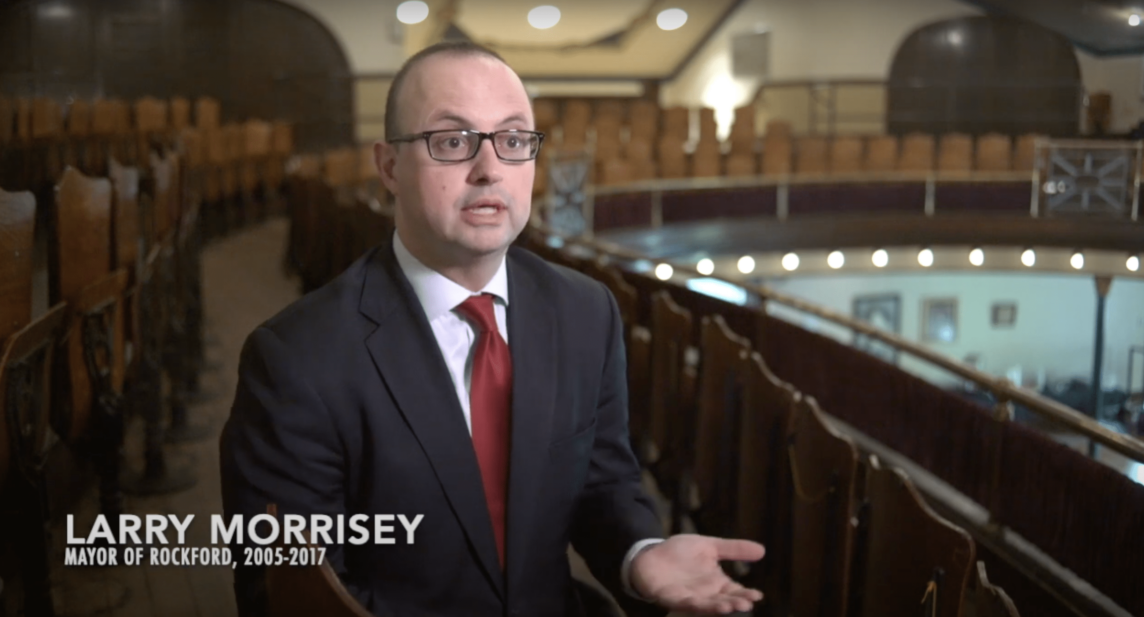
Elected leaders take accountability for ending homelessness
Larry Morrissey, the former mayor of Rockford, Illinois, reflected on his role in helping his community end chronic and veteran homelessness. In a case study published by the Bloomberg Harvard City Leadership Initiative in 2021, he described his initial caution.
“I had thought homelessness was this intractable problem we would never solve,” he said. “I didn’t want to take a pledge to end veteran homelessness unless I was deadly serious about it. Once I took the pledge, I owned it. I didn’t just sign a piece of paper.”
Morrissey showcased the powerful contributions that local elected leaders can make in accelerating a community’s path to functional zero. He championed the aim of ending homelessness at the population level, insisted that comprehensive, real-time data on homelessness be collected to measure progress, and advocated that all resources and activities supported progress toward zero. With this strong support from Morrissey — which was maintained by his successor, Mayor Tom McNamara — Rockford demonstrated how a community can end homelessness and sustain that standard for years.
In 2021, Community Solutions sought to learn how mayors currently understand their roles in relation to homelessness. With support from Citi and the Rockefeller Foundation, we partnered with Boston University’s Initiative on Cities for the 2021 Menino Survey of Mayors. Based on interviews with 126 mayors from 39 states, the survey captured mayoral perspectives on their roles and challenges in ending homelessness.
Milestones
Community Solutions partnered with Boston University’s Initiative on Cities for the 2021 Menino Survey of Mayors to understand mayoral perspectives on ending homelessness.
Learnings
- Mayors believe they are held responsible for addressing homelessness in their cities, but feel they have little control. An overwhelming majority of mayors (73%) perceive themselves as being held highly accountable for addressing homelessness in their communities, but 81% feel that homelessness is outside of their control.
- A strong majority of mayors do not define policy success as reducing homelessness, and a surprising number do not have clear definitions for success. In fact, 60% of mayors do not define success by whether their cities are reducing homelessness.
- Mayors do not have access to the data that they need to solve homelessness, which is exacerbated by challenges in coordination across cities, counties, and nonprofits. Mayors regularly lack basic information to understand the scale and nature of homelessness in their cities. One in 10 mayors said that they do not have access to city-level data at all. Though homelessness is a dynamic problem that changes every night, the largest proportion of respondents (38%) cited annual estimated street counts as their principal source of information. Mayors observed that it was especially difficult to count members of their unsheltered population.
These findings confirmed the urgent need and value of helping communities establish the operating systems needed to solve homelessness, which are grounded in a shared aim; quality, real-time data; and a single team that can align different areas of government and not-for-profit activity. It also highlighted mayoral perceptions and behaviors that must change to accelerate progress to zero in communities, like defining success as reductions in homelessness. Community Solutions will collaborate again with the Menino Survey of Mayors in 2023 and 2025 to continue understanding and tracking changes in mayoral responses to homelessness.

Creating public accountability
The belief that homelessness can’t be solved is a self-fulfilling prophecy. New expectations are needed to place us on a path to making homelessness rare and brief, everywhere.
Communities are proving that homelessness can be ended, not only for individuals, but for entire populations. But history tells us that evidence alone is not enough. Scaling a breakthrough innovation requires shifts in attitudes that create new expectations of leaders. This has informed our #HomelessnessIsSolvable campaign, geared at creating public accountability for ending homelessness and highlighting the behaviors of key leaders who are driving measurable reductions in homelessness.
Milestones
Community Solutions launched #HomelessnessIsSolvable, a campaign to amplify the stories of communities reducing and ending homelessness. These stories have also highlighted the roles played by leaders in business, elected office, faith communities, and health care.
Learnings
The media and public can make ending homelessness the expectation by holding leaders accountable for reaching functional zero.
Solving homelessness across an entire community is complex. It’s impossible if the key actors are not aligned on the end goal and how it will be measured. Accountability begins with a single, shared definition for ending homelessness that is widely understood as the measure of success.
Functional zero provides the clear, objective, and measurable definition required to tell a community that homelessness is rare overall within its boundaries, brief when it occurs, and that this result is being sustained over time.
Communities are increasingly using and reaching functional zero as the gold standard for ending homelessness. Between 2020 and 2021, Community Solutions tracked a greater than 200% increase in references to functional zero in news media. While these mentions signaled increased usage, they also called attention to common misunderstandings and instances of misuse. In 2022, Community Solutions will focus on public and media education around the functional zero definition, both nationally and locally.
Solving homelessness requires a new understanding of the problem.
Homelessness is widely misunderstood as a problem stemming from individual choices or circumstances, rather than failing systems. For decades — and still today — policies and approaches grounded in this mindset have failed to reduce and end homelessness.
By contrast, the communities reducing homelessness, like Rockford, Illinois, concentrate on where their systems are failing and on building accountability to fix them.
Jennifer Jaeger, Community Services Director in Rockford, Illinois, has a rule. No one is allowed to blame a person’s homelessness on their individual characteristics. She keeps the local team’s conversations focused on the real cause of homelessness: system barriers.
“Nobody is allowed to say something like, ‘we can’t house him, because he’s drunk all the time,’” Jaeger said. “We must focus on: what is it about our community, and our housing structure, and our landlords, and our other systems that is keeping that person on the street. How can we overcome that system barrier and house that person?”
This understanding must drive the work of service providers, elected officials, leaders, and constituents across a community. To advance this message — and understanding of what accountable systems can achieve — Community Solutions launched the Homelessness is Solvable campaign in October 2021.

#HomelessnessIsSolvable
Visit HomelessnessIsSolvable.org to see if your community is a part of Built for Zero and read the latest stories of communities reducing and ending homelessness. Understand what actions you can take to support progress within your community, whether as a citizen, a faith leader, a health system, or an elected official.
More from the 2021 Impact and Learning Report

The future we can build, together
It’s 2026. Homelessness is no longer seen as intractable, and ending it is no longer seen as exceptional. It’s expected.
